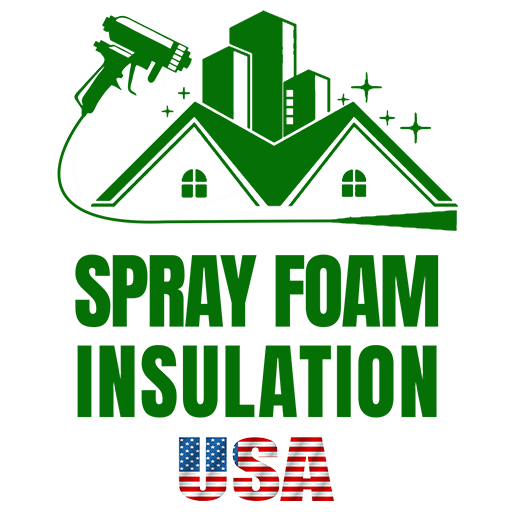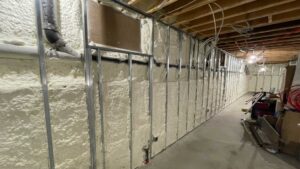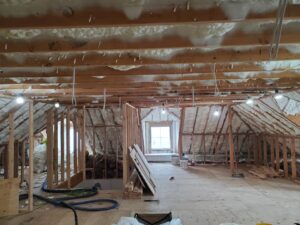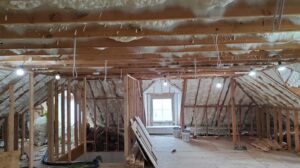Attic Insulation Removal: Understanding the process and importance can save you considerable hassle and expense. Effective attic insulation is crucial for maintaining your home’s energy efficiency, comfort, and safety. Over time, however, insulation may become compromised due to factors such as mold, water damage, or rodent infestations, necessitating its removal and replacement.
Key Points for Quick Reference:
– Safety First: Check for asbestos, especially in homes built before 1980.
– Inspect for Damage: Look for signs of mold, rodent infestation, or water damage.
– Choose the Right Tools: Equip yourself with proper safety gear and rent a high-powered vacuum for removal.
– Dispose Responsibly: Learn about local regulations for disposing of old insulation materials.
Maintaining the right attic insulation is more than just about comfort; it directly impacts your home’s energy bills and environmental footprint. Common issues affecting attic insulation include:
– Asbestos Risks: Present in many older homes, posing serious health risks.
– Mold Growth: Can lead to significant health issues and structural damage.
– Rodent and Pest Infestations: Compromise insulation integrity and pose health risks.
Removing old, damaged insulation is the first step towards upgrading your home’s thermal efficiency and creating a healthier living environment.
Assessing Your Attic Insulation
Before you begin the process of attic insulation removal, it’s crucial to assess the current condition of your insulation. Identifying potential hazards like asbestos, mold, rodent infestations, and water damage early can save you time and ensure safety throughout the removal process.
Asbestos
Asbestos is a hazardous material that was commonly used in insulation products between 1930 and 1950. If your home falls within this age range, test for asbestos before proceeding. The U.S. Consumer Product Protection Agency strongly advises against handling asbestos yourself. Instead, purchase a testing kit from a home improvement store or hire a professional inspector. If asbestos is detected, you must engage a licensed removal specialist to handle the disposal safely.
Mold
Mold in attic insulation is a serious concern due to its potential health impacts, including respiratory issues. According to The Mayo Clinic, mold is a significant contributor to sinus infections. If you spot any signs of mold, it’s crucial to address this immediately. Mold remediation typically involves removing the affected insulation and treating the area to prevent future growth.
Rodents
Rodents can severely damage insulation materials with their droppings, urine, and nesting habits. Look for signs of infestation such as droppings, nests, or carcasses. Removing contaminated insulation is vital for preventing health risks associated with airborne pathogens from rodent waste.
Water Damage
Insulation that has been wet can lead to structural issues and mold growth. Check for any signs of water leakage or damp insulation materials. Addressing the source of moisture and replacing wet insulation are critical steps in maintaining the structural integrity and air quality of your home.
By thoroughly assessing your attic for these issues, you can ensure a safe and effective insulation removal process. Dealing with hazardous materials and significant infestations often requires professional intervention to ensure safety and compliance with local regulations. Once your attic is cleared of these hazards, you’ll be ready to move on to the actual removal process, setting the stage for a more energy-efficient and healthier home environment.
Preparing for Attic Insulation Removal
Before you dive into the task of attic insulation removal, proper preparation is crucial. This includes gearing up with the right protective wear, renting necessary equipment, and preparing the area to ensure a smooth and safe operation.
Protective Gear
Safety first! Before stepping into your attic, make sure you are well-protected:
- Gloves: Opt for rubber-coated gloves for better grip and protection against irritants.
- Mask: A 95-rated mask is essential to avoid inhaling dust and other particles.
- Eye Protection: Choose goggles with an Anti-Fog coating to maintain clear vision throughout the task.
- Hooded Coveralls: These will shield your skin from itchy insulation fibers and other contaminants.
- Headlight: A hands-free headlight is invaluable in the dimly lit confines of an attic.
Equipment Rental
Depending on the type of insulation you are dealing with, you might need specific tools. Here’s what you might consider renting:
- Insulation Removal Vacuum: Essential for efficiently removing blown-in cellulose or loose-fill fiberglass.
- HEPA Filtered Shop-Vac: Useful for cleaning up residues after the bulk of the insulation has been removed.
- Ladder: Ensures safe access to higher sections of the attic.
Local tool rental services often provide these items at a reasonable rate, and staff can advise on the best tools for your specific needs.
Area Preparation
Preparing the area is crucial to prevent contamination of the rest of your home and to facilitate easy access and movement within the attic:
- Clear a Path: Ensure there is a clear route from your home entrance to the attic access. This helps in moving equipment in and out smoothly.
- Protect Surfaces: Use plastic sheeting or drop cloths to cover floors and walls along the path to and from the attic. Secure these with tape to prevent slippage.
- Lighting: Set up additional lighting if your headlight isn’t sufficient. Well-lit conditions reduce the risk of accidents.
- Ventilation: Good ventilation is crucial, especially in dusty environments. If possible, use a fan to help circulate air.
By setting up your workspace thoughtfully, you can enhance safety and efficiency, reducing the overall stress and difficulty of the project. With your gear ready, equipment rented, and area prepared, you’re set to move forward with the attic insulation removal process.
Step-by-Step Attic Insulation Removal Process
Clearing the Area
Before diving into the removal of attic insulation, it’s crucial to ensure the area is safe and clear of hazards.
-
Asbestos Testing: If your home was built before 1980, there’s a chance your insulation could contain asbestos. This material can be harmful if disturbed. Hire professionals to take samples and have them tested in a lab. If asbestos is detected, professional removal is a must.
-
Mold Remediation: Wet insulation can breed mold, which poses health risks. Inspect for any signs of mold. If found, consider hiring a remediation expert to safely remove it before you proceed.
-
Rodent Control: Look for signs of rodents, such as droppings or nests. If rodents are present, you might need to clear the infestation and sanitize the area to prevent health hazards.
Removing Old Insulation
Once the area is clear, you can begin removing the old insulation. Here’s how to tackle different types:
-
Blown-in Insulation: Use a high-powered vacuum designed for insulation removal. These can often be rented from hardware stores. Ensure you wear a good-quality mask or respirator to avoid inhaling fine particles.
-
Batt Insulation: This type is usually easier to handle but be careful not to tear it as you remove it. Wear gloves and long sleeves to avoid irritation from the fibers.
-
Using a Shop Vac: For smaller or hard-to-reach areas, a shop vac with a HEPA filter can be useful. This helps ensure that smaller particles are captured and not released into the air.
-
Safety Precautions: Always wear protective clothing, including goggles, gloves, and a respirator. Keep your workspace well-ventilated and take regular breaks to avoid overheating or overexposure to dust.
Cleaning and Preparing the Attic
After all the old insulation is removed, cleaning up thoroughly is crucial before installing new insulation.
-
Vacuuming: Go over the entire area with your vacuum to remove any lingering debris and dust. Pay special attention to corners and crevices where particles might accumulate.
-
Dusting: Use damp cloths to wipe down all surfaces. This helps capture any dust that the vacuum might have missed.
-
Air Sealing: Before installing new insulation, seal any gaps or holes in the attic. This can be done using caulk or spray foam. This step helps improve energy efficiency and prevents future insulation issues.
By following these detailed steps, you ensure that your attic is not only clean but also optimized for new insulation. This process helps enhance your home’s energy efficiency and overall comfort. Once the attic is prepared, you can consider upgrading to high-quality spray foam insulation for long-lasting benefits.
Disposal and Recycling of Old Insulation
When it comes to attic insulation removal, disposing of or recycling the old insulation is a step you can’t skip. Here’s what you need to know about handling different types of insulation once it’s out of your attic.
Fiberglass Recycling
Fiberglass insulation is one of the most common materials used in attics and, fortunately, it can often be recycled. Many manufacturers will take back old fiberglass to create new insulation products. This is not only eco-friendly but also reduces the amount of waste going to landfills.
To recycle fiberglass, you’ll need to:
– Check for a local recycling facility that accepts fiberglass insulation.
– Ensure the insulation is dry and free from contaminants like mold or rodent waste.
– Package it as directed by the recycling facility, usually in clear bags for easy inspection.
Cellulose Disposal
Unlike fiberglass, cellulose insulation typically can’t be recycled due to the fire retardants added to the material. These chemicals make it unsafe to reuse the insulation in new products. However, cellulose is biodegradable and can sometimes be composted.
For disposing of cellulose insulation, follow these steps:
– Contact your local waste management to see if cellulose can be included in regular trash collection.
– If not, ask about designated disposal days or facilities for such materials.
– Always use sealed bags to prevent fibers from becoming airborne.
Local Regulations
Each area has its own rules about disposal and recycling of construction materials, including insulation. It’s essential to:
– Check with your local environmental agency or waste management service for specific guidelines.
– Find out if there are any special requirements or permits needed for insulation disposal.
– Respect local regulations to avoid fines and support community health and safety standards.
By responsibly disposing of or recycling your old attic insulation, you contribute to environmental sustainability and ensure compliance with local laws. This step is crucial in the process of upgrading your attic’s insulation system.
Moving forward, consider the benefits of modern insulation solutions like spray foam, which offers superior energy efficiency and durability, enhancing the comfort and value of your home.
Upgrading Your Attic Insulation
After successfully removing your old attic insulation, it’s time to consider upgrading to a more efficient solution. Spray foam insulation is a top choice due to its numerous benefits.
Benefits of Spray Foam Insulation
Spray foam insulation stands out because it expands to fill gaps, creating a tight seal that significantly reduces air leaks. Here’s why it’s a preferred option:
- Seals Cracks and Gaps: Unlike traditional insulation types, spray foam expands upon application, effectively sealing off any cracks and crevices. This barrier keeps outside air from entering and conditioned air from escaping, making your home more comfortable.
- Moisture Barrier: Spray foam provides an excellent moisture barrier, preventing water and moisture from penetrating through your attic. This reduces the risk of mold and mildew, contributing to a healthier home environment.
- Durability: Unlike other insulation materials that can sag or settle over time, spray foam maintains its shape and effectiveness, providing a long-lasting insulation solution that doesn’t require frequent updates or checks.
Energy Efficiency
Upgrading to spray foam insulation can lead to significant energy savings. By creating an airtight seal, spray foam minimizes the workload on your heating, ventilation, and air conditioning (HVAC) system. Homes with spray foam insulation often see reduced energy bills because their HVAC systems do not need to work as hard to maintain a comfortable indoor temperature, regardless of the season.
HVAC System Longevity
By reducing the demand on your HVAC system, spray foam insulation helps extend the life of your heating and cooling units. With less strain and more consistent internal temperatures, the wear and tear on your HVAC system are significantly reduced. This not only prolongs the lifespan of your equipment but also decreases the frequency and cost of maintenance and repairs.
Upgrading your attic insulation to spray foam is a smart move for any homeowner looking to enhance their home’s energy efficiency, comfort, and overall value. With its superior sealing capabilities and long-term durability, spray foam insulation provides a reliable way to protect your home against energy loss and external elements. A well-insulated home is a step towards a more sustainable and cost-effective living environment.
Frequently Asked Questions about Attic Insulation Removal
Is it worth it to remove old attic insulation?
Removing old attic insulation can be very beneficial. It allows you to replace it with more efficient materials, like spray foam, which can enhance your home’s energy efficiency. This upgrade can lead to significant savings on your heating and cooling bills. Additionally, removing old insulation can address health concerns related to mold, pests, or outdated materials like asbestos.
Case Study: A homeowner reported their heating bill dropped by over half during the winter after replacing their old insulation with a more efficient option. This illustrates the potential financial benefits of upgrading your attic insulation.
Can I remove attic insulation myself?
Yes, it is possible to remove attic insulation yourself, especially if you are handy and have the right tools. However, it requires preparation, the right safety gear, and knowledge of how to handle and dispose of old insulation materials. For instance, batt insulation can be rolled up and bagged, while blown-in insulation might need a specialized vacuum to be removed efficiently.
Safety Tip: Always wear protective gear such as gloves, a mask, and eye protection. If your insulation is very old or you suspect it contains harmful substances like asbestos, it’s safer to hire professionals.
How much does it cost to remove attic insulation?
The cost of attic insulation removal varies depending on several factors, including the size of your attic, the type of insulation, and whether you do it yourself or hire professionals. For a DIY project, costs can range from $1,000 to $1,500 for a 1,500 square foot attic. If you choose to hire professionals, the cost could be between $2,000 and $3,000 for the same size space.
Consideration: While DIY can reduce costs, professional removal might be more thorough and faster, and it reduces your exposure to potential irritants or toxins.
Removing old attic insulation and upgrading to a high-quality option like spray foam can significantly improve your home’s comfort, air quality, and energy efficiency. Whether you decide to tackle the project yourself or hire professionals, understanding the scope and potential benefits will help you make an informed decision. Investing in your home’s insulation is investing in a healthier, more energy-efficient living space.
Conclusion
After exploring the detailed process of attic insulation removal, it’s clear that tackling this project can be extensive and requires a meticulous approach. While it’s feasible for some homeowners to manage on their own, the importance of professional help cannot be overstated. This is where our team at Spray Foam Insulation USA steps in to ensure that your attic insulation upgrade is handled expertly.
Why Opt for Professional Help?
Removing attic insulation involves more than just physical labor. It includes handling potential hazards such as mold, asbestos, and rodent contaminants that could pose health risks. Professionals are equipped with the right tools, knowledge, and experience to navigate these challenges safely and efficiently. Here’s why enlisting expert help is crucial:
- Safety First: Professionals are trained to deal with hazardous materials and ensure that all safety protocols are followed, reducing the risk of exposure to allergens, toxins, and irritants.
- Efficiency: Professional teams can complete the job quicker than a DIY approach, thanks to their expertise and specialized equipment. This means less disruption to your daily life and quicker installation of new insulation.
- Quality of Work: Experts ensure that the removal and installation are done correctly, which affects the long-term performance of your insulation. Proper installation ensures maximum energy efficiency and cost savings on heating and cooling bills.
- Disposal and Recycling: Professionals know how to dispose of or recycle old insulation materials according to local regulations, ensuring environmental compliance.
Choosing Spray Foam Insulation USA
At Spray Foam Insulation USA, we don’t just remove old insulation; we upgrade your home’s energy efficiency with high-quality spray foam insulation. This type of insulation not only seals air leaks but also provides excellent thermal resistance and structural integrity to your home. Here are a few reasons to choose us for your attic insulation needs:
- Tailored Solutions: We assess your specific needs and provide a customized insulation solution that best fits your home.
- Expert Installation: Our team’s precision and attention to detail ensure that every corner of your attic is properly insulated.
- Energy Savings: Spray foam insulation can significantly reduce your heating and cooling costs by creating an airtight seal that minimizes energy leaks.
- Enhanced Home Comfort: Experience consistent indoor temperatures and improved air quality, making your home comfortable year-round.
Investing in professional attic insulation removal and upgrade services from Spray Foam Insulation USA is not just about improving energy efficiency—it’s about enhancing the overall comfort and health of your living environment. Ready to take the next step? Contact us today for a free estimate and see how we can transform your attic into a more energy-efficient space.
By choosing professional help for your attic insulation project, you ensure a safer, faster, and more effective upgrade to your home’s comfort and efficiency. Let us help you make your home the best it can be.





